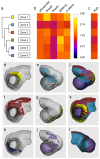Atlas Toolkit: Fast registration of 3D morphological datasets in the absence of landmarks
- PMID: 26864723
- PMCID: PMC4749973
- DOI: 10.1038/srep20732
Atlas Toolkit: Fast registration of 3D morphological datasets in the absence of landmarks
Abstract
Image registration is a gateway technology for Developmental Systems Biology, enabling computational analysis of related datasets within a shared coordinate system. Many registration tools rely on landmarks to ensure that datasets are correctly aligned; yet suitable landmarks are not present in many datasets. Atlas Toolkit is a Fiji/ImageJ plugin collection offering elastic group-wise registration of 3D morphological datasets, guided by segmentation of the interesting morphology. We demonstrate the method by combinatorial mapping of cell signalling events in the developing eyes of chick embryos, and use the integrated datasets to predictively enumerate Gene Regulatory Network states.
Figures



Similar articles
-
Anatomical landmarks for registration of experimental image data to volumetric rodent brain atlasing templates.J Neurosci Methods. 2015 Jan 30;240:161-9. doi: 10.1016/j.jneumeth.2014.11.005. Epub 2014 Nov 18. J Neurosci Methods. 2015. PMID: 25445058
-
Direct non-cell autonomous Pax6 activity regulates eye development in the zebrafish.Neural Dev. 2007 Jan 17;2:2. doi: 10.1186/1749-8104-2-2. Neural Dev. 2007. PMID: 17229313 Free PMC article.
-
3D Analysis of Human Embryos and Fetuses Using Digitized Datasets From the Kyoto Collection.Anat Rec (Hoboken). 2018 Jun;301(6):960-969. doi: 10.1002/ar.23784. Epub 2018 Apr 23. Anat Rec (Hoboken). 2018. PMID: 29682894
-
3-Dimensional modelling of chick embryo eye development and growth using high resolution magnetic resonance imaging.Exp Eye Res. 2009 Oct;89(4):511-21. doi: 10.1016/j.exer.2009.05.014. Epub 2009 Jun 18. Exp Eye Res. 2009. PMID: 19540232
-
Brain templates and atlases.Neuroimage. 2012 Aug 15;62(2):911-22. doi: 10.1016/j.neuroimage.2012.01.024. Epub 2012 Jan 10. Neuroimage. 2012. PMID: 22248580 Review.
Cited by
-
Multimodal assessments of Zika virus immune pathophysiological responses in marmosets.Sci Rep. 2018 Nov 20;8(1):17125. doi: 10.1038/s41598-018-35481-6. Sci Rep. 2018. PMID: 30459473 Free PMC article.
-
The Early Stages of Heart Development: Insights from Chicken Embryos.J Cardiovasc Dev Dis. 2016 Apr 5;3(2):12. doi: 10.3390/jcdd3020012. J Cardiovasc Dev Dis. 2016. PMID: 29367563 Free PMC article. Review.
-
The Pax6 master control gene initiates spontaneous retinal development via a self-organising Turing network.Development. 2020 Dec 23;147(24):dev185827. doi: 10.1242/dev.185827. Development. 2020. PMID: 33214222 Free PMC article.
References
-
- Megason S. G. & Fraser S. E. Imaging in systems biology. Cell. 130, 784–795 (2007). - PubMed
-
- Luengo-Oroz M. A., Ledesma-Carbayo, M. J., Peyriéras, N. & Santos A. Image analysis for understanding embryo development: a bridge from microscopy to biological insights. Curr. Opin. Genet. Dev. 21, 630–637 (2011). - PubMed
Publication types
MeSH terms
Substances
LinkOut - more resources
Full Text Sources
Other Literature Sources
Medical

